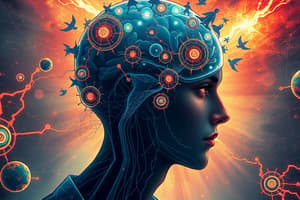Podcast
Questions and Answers
What did Wertheimer study in Gestalt psychology?
What did Wertheimer study in Gestalt psychology?
- Apparent motion (correct)
- Learning by insight
- Experimental phenomenology
- Perceptual constraints
How does experience affect the structuring of the phenomenal field according to Gestalt psychology?
How does experience affect the structuring of the phenomenal field according to Gestalt psychology?
- It has no impact on the processes.
- It influences the direction of the processes. (correct)
- It alters the physical characteristics of stimuli.
- It determines the processes completely.
What concept did Wolfgang Kohler propose in relation to learning from a Gestalt perspective?
What concept did Wolfgang Kohler propose in relation to learning from a Gestalt perspective?
- Learning by insight (correct)
- Learning through reinforcement
- Learning by imitation
- Learning through memorization
What is the main focus of the experimental phenomenological research method in Gestalt psychology?
What is the main focus of the experimental phenomenological research method in Gestalt psychology?
What does the innatist theory assert about experience in Gestalt psychology?
What does the innatist theory assert about experience in Gestalt psychology?
What is the primary objective of using simulation in cognitive modeling?
What is the primary objective of using simulation in cognitive modeling?
What is a key step in transforming a theory into a computational program?
What is a key step in transforming a theory into a computational program?
In a neural network, what happens if the output does not match the target during back propagation?
In a neural network, what happens if the output does not match the target during back propagation?
Which of the following is NOT considered an advantage of neural networks in cognitive modeling?
Which of the following is NOT considered an advantage of neural networks in cognitive modeling?
What role does the hidden layer play in a feedforward neural network?
What role does the hidden layer play in a feedforward neural network?
Who founded the first experimental psychology laboratory, marking psychology's status as an autonomous scientific discipline?
Who founded the first experimental psychology laboratory, marking psychology's status as an autonomous scientific discipline?
What was the primary research method used by Wundt in his structuralism studies?
What was the primary research method used by Wundt in his structuralism studies?
Which psychological perspective emphasizes the relationship between mental activities and objectively measurable stimuli?
Which psychological perspective emphasizes the relationship between mental activities and objectively measurable stimuli?
F. J. Gall is known for proposing which of the following concepts?
F. J. Gall is known for proposing which of the following concepts?
What is defined by Wundt as the process of identifying and synthesizing conscious sensations?
What is defined by Wundt as the process of identifying and synthesizing conscious sensations?
Which of the following aspects is NOT associated with Wundt's structuralism?
Which of the following aspects is NOT associated with Wundt's structuralism?
What did Wundt aim to capture through his research in structuralism?
What did Wundt aim to capture through his research in structuralism?
Which psychological approach is characterized by questioning the nature of consciousness and perception?
Which psychological approach is characterized by questioning the nature of consciousness and perception?
What does the human information processing (HIP) focus on?
What does the human information processing (HIP) focus on?
What significant shift occurred in cognitivism as discussed?
What significant shift occurred in cognitivism as discussed?
Which movement was launched in 1977 related to cognitive studies?
Which movement was launched in 1977 related to cognitive studies?
Which approach is associated with the idea of modularism in cognitive sciences?
Which approach is associated with the idea of modularism in cognitive sciences?
Who were the founders of the journal 'Cognitive Science'?
Who were the founders of the journal 'Cognitive Science'?
What was one of the main critiques of the mind-computer analogy in cognitivism?
What was one of the main critiques of the mind-computer analogy in cognitivism?
What is an essential characteristic of connectionism?
What is an essential characteristic of connectionism?
Which psychologist is known for the foundation of the journal 'Cognitive Science'?
Which psychologist is known for the foundation of the journal 'Cognitive Science'?
What is the main function of modules according to Fodor's theory?
What is the main function of modules according to Fodor's theory?
Which characteristic does NOT describe the central systems in Fodor's model?
Which characteristic does NOT describe the central systems in Fodor's model?
In the example of the language module presented, what is its output designed to represent?
In the example of the language module presented, what is its output designed to represent?
What was the primary objective of Connectionism as proposed by Rumelhart and McClelland?
What was the primary objective of Connectionism as proposed by Rumelhart and McClelland?
How are neural networks described in the context of cognitive processes?
How are neural networks described in the context of cognitive processes?
What limitation is associated with the central systems in Fodor's model?
What limitation is associated with the central systems in Fodor's model?
Which of the following is an incorrect pairing of a module and its function?
Which of the following is an incorrect pairing of a module and its function?
What process is primarily illustrated by the feature of 'feed-forward and back propagation' in neural networks?
What process is primarily illustrated by the feature of 'feed-forward and back propagation' in neural networks?
What is the focus of Penfield's research as a neuroscientist?
What is the focus of Penfield's research as a neuroscientist?
How does cognitivism differ from the behaviorist approach?
How does cognitivism differ from the behaviorist approach?
What does the 'Test-Operate-Test-Exit' model primarily describe?
What does the 'Test-Operate-Test-Exit' model primarily describe?
In the 'Test-Operate-Test-Exit' model, what is the primary purpose of the 'Operate' phase?
In the 'Test-Operate-Test-Exit' model, what is the primary purpose of the 'Operate' phase?
What is the initial step when applying the 'Test-Operate-Test-Exit' model?
What is the initial step when applying the 'Test-Operate-Test-Exit' model?
What is the ultimate goal of the 'Test-Operate-Test-Exit' model?
What is the ultimate goal of the 'Test-Operate-Test-Exit' model?
What characteristic of the mind is emphasized by cognitivism?
What characteristic of the mind is emphasized by cognitivism?
Which concept is NOT associated with the behaviorist approach?
Which concept is NOT associated with the behaviorist approach?
Flashcards
Structuralism
Structuralism
The study of the structure and basic elements of the mind.
Who is considered the founder of experimental psychology?
Who is considered the founder of experimental psychology?
Wilhelm Wundt, a German psychologist, is considered the founder of experimental psychology.
What is introspection?
What is introspection?
Introspection is a technique where individuals carefully observe and report their own thoughts, feelings, and sensations.
What is phrenology?
What is phrenology?
Signup and view all the flashcards
What is apperception?
What is apperception?
Signup and view all the flashcards
What was the aim of Wundt's research?
What was the aim of Wundt's research?
Signup and view all the flashcards
How did Wundt study the mind?
How did Wundt study the mind?
Signup and view all the flashcards
What did Wundt believe about psychology?
What did Wundt believe about psychology?
Signup and view all the flashcards
Gestalt Psychology
Gestalt Psychology
Signup and view all the flashcards
Apparent Motion (Stroboscopic)
Apparent Motion (Stroboscopic)
Signup and view all the flashcards
Phenomenal Field
Phenomenal Field
Signup and view all the flashcards
Learning by Insight (Gestalt)
Learning by Insight (Gestalt)
Signup and view all the flashcards
Innatist Theory (Gestalt)
Innatist Theory (Gestalt)
Signup and view all the flashcards
Penfield
Penfield
Signup and view all the flashcards
Cognitivism
Cognitivism
Signup and view all the flashcards
T.O.T.E. Model
T.O.T.E. Model
Signup and view all the flashcards
Test (T.O.T.E.)
Test (T.O.T.E.)
Signup and view all the flashcards
Operate (T.O.T.E.)
Operate (T.O.T.E.)
Signup and view all the flashcards
Test (T.O.T.E.)
Test (T.O.T.E.)
Signup and view all the flashcards
Exit (T.O.T.E.)
Exit (T.O.T.E.)
Signup and view all the flashcards
Active Processor of Information
Active Processor of Information
Signup and view all the flashcards
Mind-computer analogy
Mind-computer analogy
Signup and view all the flashcards
Modularism
Modularism
Signup and view all the flashcards
Connectionism
Connectionism
Signup and view all the flashcards
Cognitive Sciences
Cognitive Sciences
Signup and view all the flashcards
Ecological approach
Ecological approach
Signup and view all the flashcards
Human Information Processing (HIP)
Human Information Processing (HIP)
Signup and view all the flashcards
Mentalist psychology
Mentalist psychology
Signup and view all the flashcards
Computational Model
Computational Model
Signup and view all the flashcards
Verbal Theory
Verbal Theory
Signup and view all the flashcards
Theory to Program
Theory to Program
Signup and view all the flashcards
Model Evaluation
Model Evaluation
Signup and view all the flashcards
Representation
Representation
Signup and view all the flashcards
Modules
Modules
Signup and view all the flashcards
Fodor's Modularism
Fodor's Modularism
Signup and view all the flashcards
Central System
Central System
Signup and view all the flashcards
Connectionist Network
Connectionist Network
Signup and view all the flashcards
Backpropagation
Backpropagation
Signup and view all the flashcards
Feedforward Network
Feedforward Network
Signup and view all the flashcards
Study Notes
Course Information
- Course Title: History of Experimental Psychology
- University: Università Cattolica del Sacro Cuore
- City: Milan
- Instructor: Claudia Repetto
Table of Contents (TOC)
- Precursors
- Wundt and Structuralism
- James and Functionalism
- Freud and Psychoanalysis
- Watson and Behaviorism
- Gestalt
- Penfield and the Biological Perspective
- Cognitivism
Timeline of Main Events and People
- 1879: Wilhelm Wundt establishes the first experimental psychology laboratory at the University of Leipzig. This is considered the start of psychology as an independent scientific field.
- 1860 - 1900: Important figures in the development of psychology include Descartes (1596 - 1650), and Gall (1758 - 1828) and others.
- 1913: J.B. Watson's article marks the beginning of behaviorism.
- 1935: Koffka publishes "Principles of Gestalt Psychology".
- 1955: Wilder Penfield's work in neuroscience.
- 1977: The concept of "Cognitive Sciences" emerges.
F.J. Gall and Phrenology
- Gall proposed that cognitive functions are localized in specific brain areas.
- Innate faculties develop corresponding brain areas that grow and deform.
- Skull morphology can indicate personality traits through identified peculiarities in the brain regions.
Wundt and Structuralism
- Psychology's focus is on unmediated personal experiences.
- These experiences correlate with mental processes, running alongside objectively measurable stimuli and responses.
- Apperception is the basic mental activity, involving the identification, qualification, and synthesis of conscious sensations.
- Introspection is the research method used. It involves subjects describing their consciousness in response to precisely controlled stimuli.
Wundt and Structuralism (Continued)
- Purpose of research: capture variations in unmediated experiences as stimuli change.
- Research Method: Introspection. Wundt believed introspection allowed investigation into states of consciousness in controlled lab settings. Wundt presented subjects with measurable stimuli and asked them to describe their responses in detail (sensations, images, emotions, etc).
Limitations of Introspection
- Accessibility issues existed with specific individuals (e.g., children, mentally ill).
- Subjectivity and inaccessibility to others' introspections further limited generalizability.
Structuralism's Aim
- Structuralism aimed to break down the mind into its most basic psychological processes, like mental chemistry.
- These basic processes combine to form more complex mental functions.
- Mental activity is not considered a substance but a set of processes.
James and Functionalism
- James's theory, Functionalism, contrasted with Structuralism. It was interested in mental processes' functions rather than their content.
- Consciousness is considered a continuous flow, not a series of elements.
- Early functionalists viewed psychology as exploring how minds function and the causality of mental processes.
James and Functionalism (Continued)
- Attention on "function" was stimulated by Darwin's evolutionary studies.
- Mental processes, the product of evolution, must be studied as wholes, not fragmented into inconsequential elements.
- Functionalism influenced developmental and animal psychology.
James and Functionalism (Continued)
- Functionalism sought pragmatic application and was opposed to purely theoretical psychology.
- Psychology moved increasingly into applied fields with the development of tests (e.g., Cattell).
- Concepts like work psychology and the role of psychological factors in work emerged.
Freud and Psychoanalysis
- Freud emphasized the unconscious mind.
- The unconscious mind, as a real driving force of the human psyche, manifests in slips, dreams, and seemingly random events.
- The "iceberg metaphore" illustrates this concept, representing conscious, preconscious, and unconscious layers.
Freud and Psychoanalysis (Continued)
- The mind is divided into three parts: the id, ego, and superego.
- The id seeks immediate pleasure.
- The ego mediates between the id and the external world.
- The superego represents internalized morals.
Watson and Behaviorism
- Psychology's focus is on observable behaviors.
- Introspection is considered subjective and invalid.
- Behaviors are linked to environmental stimuli.
Watson and Behaviorism (Continued)
- The process of learning, including conditioning and reinforcement, is central to observable behavior.
- The classic 'Little Albert' experiment exemplifies this behavioral approach.
Gestalt Psychology
- Gestalt, emerging in early 20th-century Europe, differed from those approaches that segmented the mind.
- It emphasizes the importance of the whole and not just the parts.
- The whole is more than the sum of its parts.
Gestalt Psychology (Continued)
- Key figures like Wertheimer are associated with the development of Gestalt psychology and its study of apparent motion (stroboscopic motion).
- Gestalt psychology mainly examines areas like thinking and perception.
- A phenomenological experimental approach evaluates perceptual changes linked to physical stimulus characteristics.
Gestalt Psychology (Continued)
- Experience impacts the orientation of mental processes; however, basic processes are not determined by experience but rather by innate factors.
- Insight, a sudden understanding in problem-solving, is relevant to the nature of learning.
Wilder G. Penfield and the Biological Perspective
- The biological perspective, emphasizing the link between the brain's chemical activity and behavior, is examined.
- His contributions to our understanding of neurological functions and their link to both mental and behavioral processes.
- Emphasized the brain's chemical activity's role in influencing human processes.
Cognitivism
- The mind is viewed as an active information processor, contrasting with less active views.
- Cognitivism proposed that mental activity is an important area of study, counterbalancing the more behaviorally oriented approaches.
Cognitivism (Continued)
- The TOTE model of problem solving is critical to understanding information processing.
- The model’s “Test-Operate-Test-Exit” protocol is a cyclic process in problem-solving which includes steps like testing the process, operating the action, then testing again until satisfactory.
Cognitivism (Continued)
- The "mind-computer analogy" and the concept of "information processing" are significant.
- This led to a more ecological view.
- The emergence of "cognitive science" as a separate discipline, along with alternative approaches like modularism and connectionism.
Modularism
- The mind's activity is described as the generation of internal representations.
- External stimuli become representations.
- Processes for transformation to internal units are performed by "modules." (Fodor, 1983).
Connectionism
- Connectionism, or neural networking, is a way to model neural processes in the brain emphasizing the interconnections of multiple units.
- Information passes to the units from input to hidden units then the output units.
- Backwards propagation updates weights of interconnections based on target comparison and output mismatches.
Neural Networks: Applications
- Modeling cognitive processes.
- Simulating learning.
- Modeling deficits or impairments.
Neural Networks: Advantages
- Well-defined hypotheses are encouraged.
- Rigorous study of mental processes is better supported.
- Models for internal mental process manipulations related to deficits are possible.
Studying That Suits You
Use AI to generate personalized quizzes and flashcards to suit your learning preferences.




